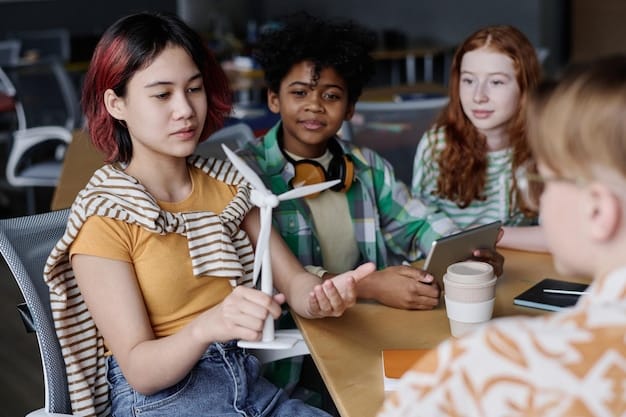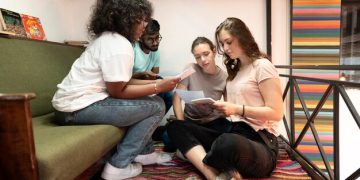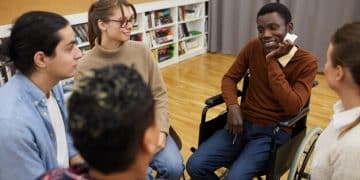Addressing Learning Disabilities in Gen Z: Early ID & Intervention

Navigating the rising prevalence of learning disabilities among Generation Z necessitates proactive strategies for early identification and targeted intervention to foster inclusive educational environments and ensure every student reaches their full potential.
Generation Z, often characterized by its digital fluency and diverse perspectives, is increasingly facing a subtle yet significant challenge: a rise in identified learning disabilities. Understanding and effectively Addressing the Rise in Learning Disabilities Among Gen Z: Early Identification and Intervention Techniques is paramount for educators, parents, and policymakers alike to ensure this generation thrives academically and personally.
The Shifting Landscape of Learning Disabilities in Gen Z
The landscape of learning disabilities is evolving, and Generation Z finds itself at a unique intersection of societal changes, technological advancements, and increased diagnostic awareness. Unlike previous generations, Gen Z has grown up immersed in an unprecedented digital world, which, while offering numerous benefits, also presents new challenges for cognitive development and learning patterns. This section explores the multifaceted factors contributing to the perceived increase in learning disabilities within this demographic.
One primary factor is the expanded understanding and diagnostic criteria for various learning disabilities. What might have been dismissed as simply “struggling in school” in past decades is now recognized and classified, leading to more students receiving formal diagnoses. This increased awareness extends beyond traditional settings into broader public discourse, normalizing conversations around neurodiversity and specific learning differences.
Furthermore, the academic pressures faced by Gen Z are arguably higher than ever. With standardized testing, rigorous curricula, and immense competition for higher education, students are pushed to perform at elevated levels. This intensified environment can make underlying learning challenges more apparent, as students struggle to keep pace with demands not always tailored to diverse learning styles.
Environmental and Digital Influences on Gen Z Learning
The constant connectivity and exposure to digital media also play a role, though often debated. While digital tools can be powerful aids, excessive screen time and fragmented attention spans, potentially fostered by constant notifications and multi-tasking, might impact deep learning and concentration abilities necessary for academic success.
- 📱 Constant digital stimulation leading to fragmented attention.
- 🧠 Over-reliance on external digital tools potentially hindering internal cognitive skill development.
- 📉 Reduced opportunities for less structured play and social interaction, which are crucial for developing foundational learning skills.
Moreover, lifestyle changes, including diet, sleep patterns, and reduced physical activity, are increasingly being investigated for their potential impact on cognitive function and overall well-being, which indirectly affects learning readiness and performance. It’s a complex interplay where educational psychology meets contemporary societal shifts, demanding a re-evaluation of how we support learners.
Finally, improved data collection and reporting mechanisms in educational systems mean that trends are now more accurately identified. As schools become more attuned to identifying and tracking learning difficulties, the numbers naturally reflect this enhanced capacity rather than solely an intrinsic rise in prevalence. The focus shifts from merely observing a numeric increase to understanding the underlying reasons and, crucially, developing effective responses.

Early Identification: The Crucial First Step
Early identification is undeniably the cornerstone of effective intervention for learning disabilities. The sooner a learning difference is recognized, the quicker tailored support can be implemented, significantly improving long-term outcomes for students. This introductory insight into early identification emphasizes proactive strategies and the integration of various assessment tools.
Traditionally, learning disabilities were often identified only after a student had experienced significant academic struggles for an extended period. This reactive approach frequently led to frustration, decreased self-esteem, and widening achievement gaps. Modern educational psychology advocates for a proactive, multi-tiered approach to identification, beginning with universal screening.
Universal screening involves administering standardized assessments to all students within a specific age group or grade level. These screenings are not diagnostic in themselves but serve as a preliminary sweep to pinpoint students who may be at risk for a learning disability. This cast-net approach ensures that no student, regardless of their background or current academic standing, is overlooked.
Comprehensive Assessment Strategies for Identification
Once a student is flagged through universal screening, a more comprehensive assessment process begins. This often involves a multi-disciplinary team, including educational psychologists, special educators, speech-language pathologists, and
pediatricians. Each professional brings a unique perspective and set of tools to piece together a complete picture of the student’s learning profile.
- 📚 Standardized tests measuring specific academic skills (reading, writing, math).
- 🗣️ Observational assessments in classroom settings, noting learning behaviors and interactions.
- 📋 Parent and teacher interviews to gather insights into the student’s history and behavior across different environments.
- 🧠 Cognitive assessments exploring areas like memory, processing speed, and executive functions.
Beyond formal assessments, ongoing formative assessment in the classroom plays a vital role. Teachers, as frontline observers, are often the first to notice consistent patterns of difficulty. Professional development for educators in recognizing early warning signs of learning disabilities is therefore critical. This includes understanding the nuances of how different learning disabilities manifest in various academic tasks and social contexts.
The ultimate goal of early identification is not merely to label a student but to understand their unique learning profile, including their strengths and challenges. This holistic understanding then provides the foundation upon which effective, individualized intervention plans can be built, preventing prolonged academic struggles and fostering a more positive learning journey from the outset. It transforms the narrative from “what’s wrong with this student?” to “how can we best support this student’s learning?”.
Effective Intervention Techniques: Tailoring Support
Once a learning disability is identified, the focus shifts to designing and implementing effective interventions. The principle guiding these efforts is individualization: what works for one student may not resonate with another, even if they share a similar diagnosis. This section explores a range of intervention techniques, emphasizing personalized approaches and the integration of various support strategies.
Intervention is not a one-size-fits-all solution; it requires a thoughtful matching of techniques to the specific needs and learning styles of the student. The process often begins with the development of an Individualized Education Program (IEP) or a 504 Plan, legally binding documents that outline the specific accommodations, modifications, and support services a student will receive to access their education.
One widely adopted intervention is explicit, systematic instruction. This method breaks down complex skills into smaller, manageable steps, providing clear explanations, ample practice opportunities, and immediate feedback. It is particularly effective for foundational skills like phonics in reading or basic arithmetic operations in math, where a sequential building of knowledge is essential.
Leveraging Technology and Multi-Sensory Approaches
Technology has emerged as a powerful ally in supporting students with learning disabilities. Assistive technologies (AT) can bypass specific areas of difficulty, allowing students to demonstrate their knowledge in alternative ways. This includes text-to-speech software, speech-to-text tools, graphic organizers, and specialized educational apps.
- 🎙️ Text-to-speech programs aiding reading comprehension and access to content.
- ✍️ Speech-to-text tools assisting students with writing difficulties.
- 🎨 Interactive software and apps providing engaging, multi-sensory learning experiences.
- 📝 Digital organizers and planners fostering executive function skills.
Multi-sensory instruction is another cornerstone technique, engaging more than one sense (sight, sound, touch, movement) simultaneously to enhance learning and memory. For instance, a student might learn a new letter by seeing it, saying its sound, and tracing it in sand. This approach caters to diverse learning preferences and strengthens neural pathways associated with learning the concept.
Beyond direct instruction, fostering self-advocacy and metacognitive skills is crucial. Students need to understand their own learning profile, recognizing their strengths and identifying strategies that work best for them. Teaching them how to advocate for their needs, whether by asking for clarification or requesting accommodations, empowers them to take an active role in their education.
Finally, a collaborative approach involving parents, teachers, specialists, and the student themselves ensures coherence and consistency in support. Regular communication and joint problem-solving maximize the effectiveness of interventions, creating a supportive ecosystem where students feel understood and capable of achieving their full potential.
The Role of Educators and Parents in Supporting Gen Z
The partnership between educators and parents forms the fundamental pillar of support for Gen Z students with learning disabilities. Their collaborative effort ensures a cohesive and consistent environment, both at school and at home, crucial for the student’s academic and emotional growth. This section underscores the distinct yet complementary roles of guardians and teachers in this vital support system.
Educators, particularly classroom teachers, are often the first to observe academic inconsistencies or behavioral patterns that suggest a learning difference. Their role extends beyond delivering curriculum; it involves being vigilant observers, empathetic facilitators, and skilled implementers of differentiated instruction. Professional development focusing on neurodiversity, inclusive teaching practices, and the early signs of learning disabilities is vital for equipping teachers with the necessary tools.
For teachers, creating an inclusive classroom environment is paramount. This means providing accommodations such as extended time on assignments, preferential seating, simplified instructions, or alternative assessment methods. It also involves fostering a culture of acceptance where students feel comfortable asking for help and where their unique learning styles are respected and celebrated, not marginalized.
Empowering Parents for Home-Based Support and Advocacy
Parents, on the other hand, bring invaluable insights into their child’s developmental history, strengths, challenges, and overall well-being outside the school setting. Their partnership with the school is essential for sharing information, reinforcing strategies learned at school, and advocating for their child’s needs.
- 🗣️ Open communication with teachers and school support staff.
- 🏡 Reinforcing learning strategies and accommodations at home.
- 📚 Advocating for appropriate services and resources within the school system.
- ❤️ Providing emotional support and fostering a growth mindset.
Empowering parents means providing them with resources, information, and training to understand their child’s specific learning disability. This might include workshops on navigating the special education system, understanding IEPS/504 Plans, or practical strategies for homework support. When parents are informed and engaged, they become powerful advocates for their children, ensuring their unique needs are met.
Both educators and parents play a critical role in fostering a student’s self-esteem and self-advocacy skills. Learning disabilities can significantly impact a student’s emotional well-being, leading to feelings of frustration, anxiety, or inadequacy. By focusing on strengths, celebrating progress, and teaching students to understand and articulate their own learning needs, adults help build resilience and confidence.
Ultimately, the success of interventions and the holistic development of Gen Z students with learning disabilities hinge on a strong, collaborative partnership between home and school. It is a shared responsibility, built on trust, communication, and a collective commitment to each student’s potential.
The Psychological and Social Impact on Gen Z Learners
Learning disabilities do not solely manifest as academic challenges; they often carry significant psychological and social ramifications for students, particularly within the impressionable years of Generation Z. Beyond struggles with coursework, these difficulties can profoundly impact self-perception, peer relationships, and mental well-being. This section delves into the intricate emotional and social landscape experienced by Gen Z learners facing such challenges, highlighting the importance of holistic support.
Academically, repeated experiences of failure or difficulty can severely erode a student’s self-esteem and intrinsic motivation. For Gen Z, who are highly attuned to social comparison through digital platforms, academic struggles can be particularly isolating. They may perceive themselves as “less intelligent” or “incapable” compared to their peers, leading to feelings of shame and inadequacy, even when their cognitive abilities are perfectly intact.
This negative self-talk often translates into observable behaviors such as withdrawal, anxiety, or even disruptive conduct, which might be misconstrued as lack of effort or defiance rather than a response to underlying frustration. The pressure to conform and succeed within a highly competitive academic environment exacerbates these internal struggles, potentially leading to significant stress and burnout.
Fostering Resilience and Social-Emotional Well-being
Socially, navigating learning disabilities can be equally challenging. Students might struggle with social cues, communication, or executive functions that impact their ability to organize group projects or participate effectively in social interactions. This can lead to difficulties forming and maintaining friendships, increasing feelings of loneliness and isolation.
- 😟 Increased anxiety and stress related to academic performance.
- 😔 Lowered self-esteem and self-perception of intelligence.
- 🤝 Challenges in forming and maintaining peer relationships.
- 😔 Risk of depression or other mental health concerns.
The rise of social media further complicates the picture. While offering avenues for connection, these platforms also act as highlight reels of perceived success, intensifying feelings of inadequacy for those facing struggles. Cyberbullying, too, can disproportionately affect vulnerable students, adding another layer of psychological burden.
Addressing these psychological and social impacts requires a comprehensive, empathetic approach. Beyond academic accommodations, schools and parents must prioritize social-emotional learning, providing safe spaces for students to express their feelings, develop coping strategies, and build resilience. This includes access to counseling services, social skills training, and mentorship programs.
Encouraging extracurricular activities where students can explore non-academic strengths can also foster a sense of competence and belonging. Ultimately, recognizing and validating the emotional journey of Gen Z learners with disabilities is just as crucial as providing academic support, paving the way for their holistic development and well-being.

Policy and Systemic Changes for Inclusive Education
Effectively Addressing the Rise in Learning Disabilities Among Gen Z necessitates not only individual interventions but also comprehensive policy and systemic changes within educational frameworks. These broader adjustments are critical for creating truly inclusive environments that proactively support all learners, moving beyond reactive measures. This section examines the imperative for top-down reforms and the evolution of educational systems to meet these contemporary challenges, ensuring that principles of equity and accessibility are embedded at every level.
At the policy level, governments and educational bodies must continuously review and update legislation pertaining to special education. This includes ensuring adequate funding for diagnostic services, specialized teaching staff, and assistive technologies. Policies must also reflect current research in neurodiversity, moving away from outdated models that pathologize learning differences towards those that celebrate and accommodate them.
The implementation of universal design for learning (UDL) principles across all curricula is a critical systemic change. UDL aims to create learning environments that are accessible and engaging for all students from the outset, minimizing the need for extensive individual modifications later. This involves providing multiple means of representation (how information is presented), multiple means of action and expression (how students demonstrate knowledge), and multiple means of engagement (how students are motivated).
Refining Teacher Training and Resource Allocation
Teacher training programs require significant overhaul to adequately prepare educators for diverse classroom needs. Future teachers need robust instruction in inclusive pedagogies, recognizing and addressing learning disabilities, and utilizing assistive technologies effectively. Ongoing professional development for current educators is equally vital to keep pace with evolving best practices and research.
- ⚖️ Updated legislation ensuring adequate funding and modern approaches to special education.
- 🏫 Implementation of Universal Design for Learning (UDL) across all curricula.
- 🎓 Enhanced teacher training in inclusive pedagogies and neurodiversity.
- 📊 Improved data collection and monitoring systems for learning outcomes.
Another crucial area is the allocation of resources. This involves not only financial investment but also the strategic deployment of specialized professionals, such as educational psychologists, speech therapists, and occupational therapists, within school systems. Their accessibility ensures that identification and intervention are timely and sustained, providing continuous support rather than fragmented assistance.
Furthermore, systemic changes should encourage greater collaboration between schools, healthcare providers, and community organizations. This networked approach can provide a holistic support system for students and their families, addressing not just academic needs but also social-emotional well-being and access to broader community resources.
Finally, fostering a culture of data-driven decision-making within educational institutions allows for continuous improvement. By consistently collecting and analyzing data on student progress and intervention effectiveness, schools can adapt their strategies and policies to ensure they are truly making a difference for Gen Z learners with learning disabilities.
Looking Ahead: Fostering a Future of Inclusivity for Gen Z
As we delve deeper into the complexities of learning disabilities within Generation Z, it becomes clear that fostering a truly inclusive future requires not just immediate interventions but a visionary and sustained commitment. The journey ahead involves continuous adaptation, innovation, and a fundamental shift in our collective mindset about learning differences. This concluding section casts a forward gaze, outlining the enduring principles and innovative pathways essential for building an educational landscape where every Gen Z learner can thrive.
The digital fluency that defines Gen Z also presents unparalleled opportunities for personalized learning. Future educational models should leverage artificial intelligence and adaptive learning technologies to create highly individualized pathways tailored to each student’s pace, preferences, and cognitive profile. This moves beyond merely accommodating difficulties to actively optimizing learning experiences for neurodiverse minds.
Furthermore, there is a growing recognition of the importance of executive function skills—such as planning, organization, cognitive flexibility, and self-regulation—which are often areas of challenge for students with learning disabilities. Future educational approaches will increasingly integrate explicit instruction and practice in these vital life skills from an early age, preparing students not just for academic success but for navigating the complexities of adulthood.
Embracing Neurodiversity and Collaborative Ecosystems
A significant cultural shift is needed towards fully embracing neurodiversity, viewing learning differences not as deficits to be “fixed” but as natural variations in human cognition that bring unique strengths and perspectives. This involves dismantling stigmas and promoting a positive narrative around conditions like dyslexia, ADHD, and dyscalculia, highlighting the creative, innovative, and lateral thinking often associated with these minds.
- 🌐 Leveraging AI and adaptive technologies for personalized learning.
- 🎯 Prioritizing the development of executive function skills.
- 🧠 Embracing a culture of neurodiversity and celebrating diverse thinking.
- 🤝 Building stronger, collaborative ecosystems between schools, families, and communities.
The collaborative ecosystem supporting Gen Z learners must also evolve. This means stronger partnerships between schools, healthcare providers, employers, and community organizations to ensure a seamless transition for students from education into higher learning or the workforce. Vocational training programs, internships, and mentorships specifically designed for neurodiverse individuals will become increasingly crucial components of this continuum of support.
Finally, continuous research and professional development are indispensable. As our understanding of the brain and learning processes expands, so too must our strategies and tools. Educators, parents, and policymakers must commit to lifelong learning, staying abreast of the latest evidence-based practices and emerging technologies to best serve the evolving needs of each successive generation. By committing to these principles, we can ensure that Gen Z, and all future generations, are equipped with the support they need to reach their fullest potential, contributing their unique talents to a diverse and dynamic world.
| Key Point | Brief Description |
|---|---|
| 🔍 Early Identification | Proactive screening and comprehensive assessments are crucial for timely support. |
| 🛠️ Tailored Interventions | Personalized strategies, including technology and multi-sensory approaches, are key to effective support. |
| 👨🏫👪 Collaborative Support | Strong partnerships between educators and parents are vital for consistent growth. |
| 🔄 Systemic Change | Policy updates and UDL principles are essential for inclusive educational systems. |
Frequently Asked Questions About Gen Z Learning Disabilities
The perceived increase is multifaceted. It’s largely due to heightened awareness, expanded diagnostic criteria, earlier screening, and improved data collection. Increased academic pressure and lifestyle factors unique to this digital generation may also play a role, making previously undiagnosed challenges more apparent.
Early signs can include difficulty learning the alphabet or numbers, trouble with rhyming, problems following instructions, poor fine motor skills, or persistent difficulty with reading and writing despite adequate instruction. These signs vary depending on the specific learning disability.
Technology offers various assistive tools like text-to-speech, speech-to-text, and graphic organizers that help bypass areas of difficulty. It can also provide multi-sensory learning experiences and adaptive software that personalizes instruction, allowing students to access content and demonstrate knowledge more effectively.
Parents should first communicate their concerns with their child’s teacher and school. Requesting a school-based evaluation is a crucial step. Seeking advice from a pediatrician or an educational psychologist for a comprehensive assessment can also provide valuable insights and a formal diagnosis.
Social-emotional support is critically important. Learning disabilities can significantly impact self-esteem, increase anxiety, and affect peer relationships. Providing counseling, fostering self-advocacy skills, and creating inclusive environments are essential for building resilience and ensuring holistic well-being beyond academics.
Conclusion
The seemingly rising prevalence of learning disabilities within Generation Z calls for a concerted, evolving response rooted in understanding, empathy, and innovation. By prioritizing early identification through meticulous assessment, implementing tailored intervention techniques, and fostering robust partnerships between educators and parents, we can effectively mitigate academic struggles. Crucially, systemic changes emphasizing inclusivity, neurodiversity, and cutting-edge educational technologies are paramount. As Gen Z navigates a complex world, our collective commitment to providing accessible, supportive, and empowering learning environments will define their potential and contribute to a more equitable and understanding society for all learners.





